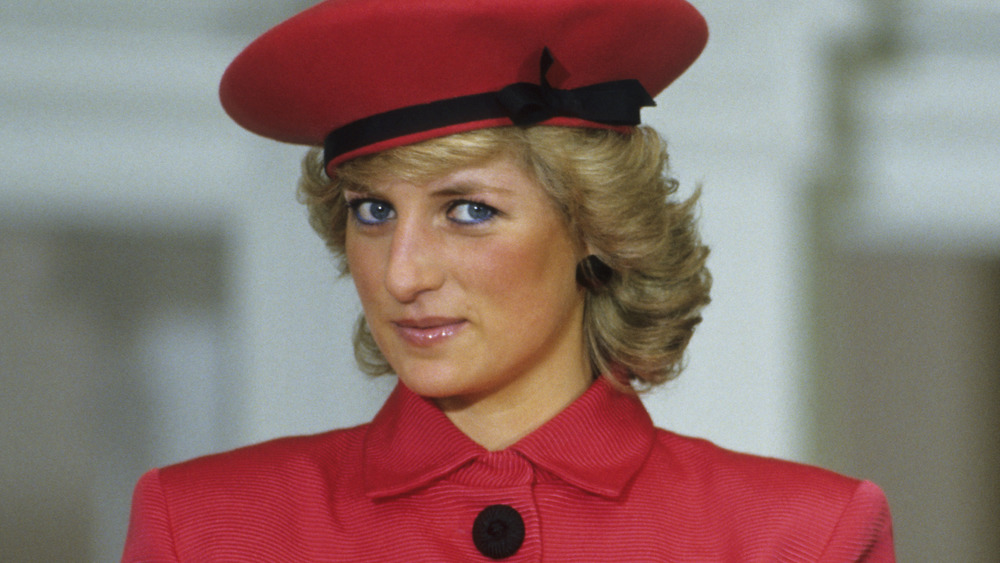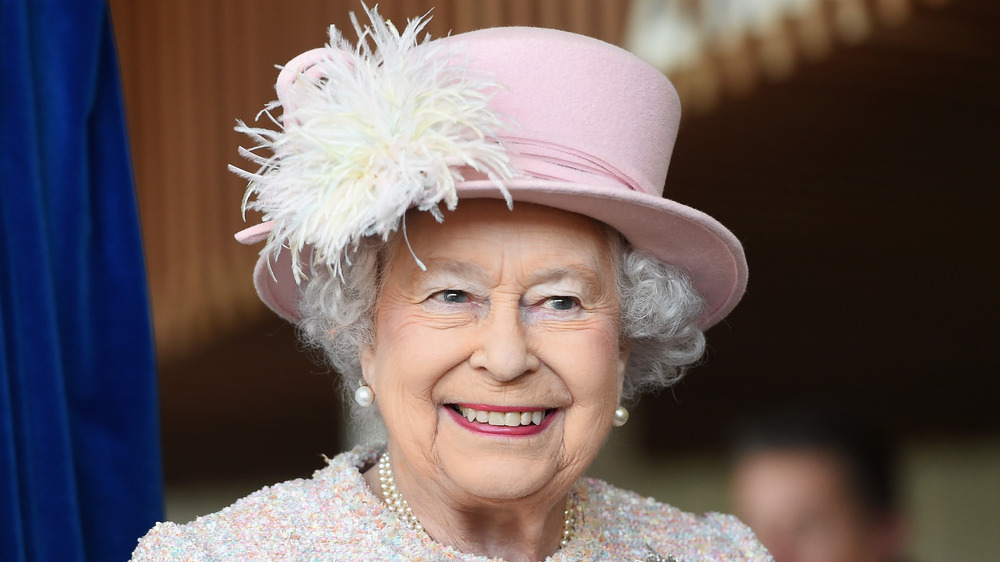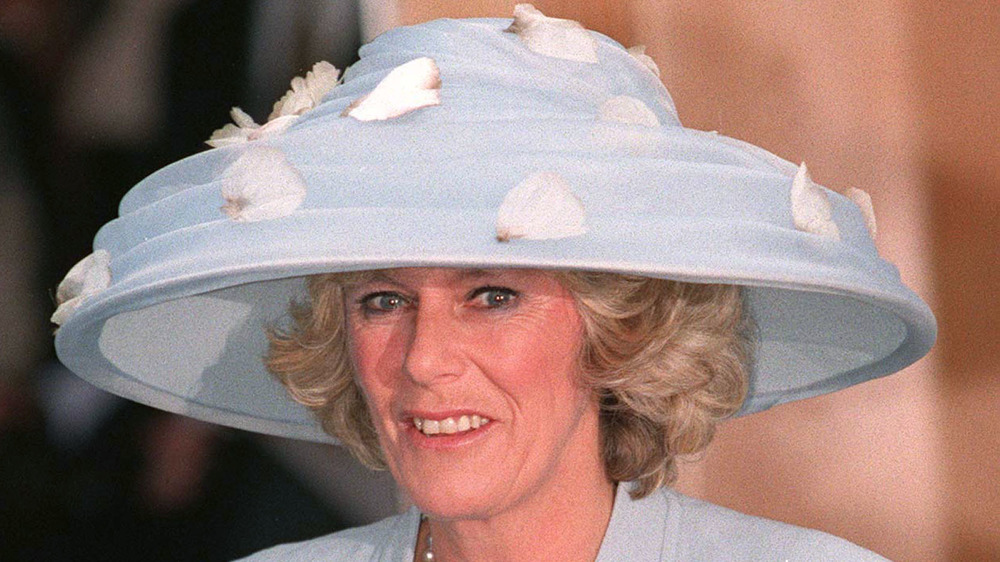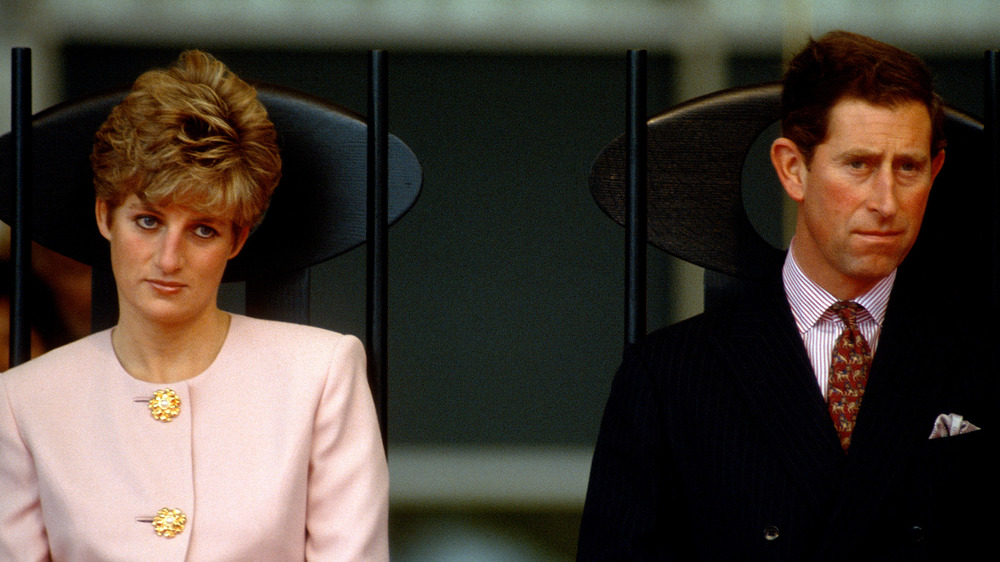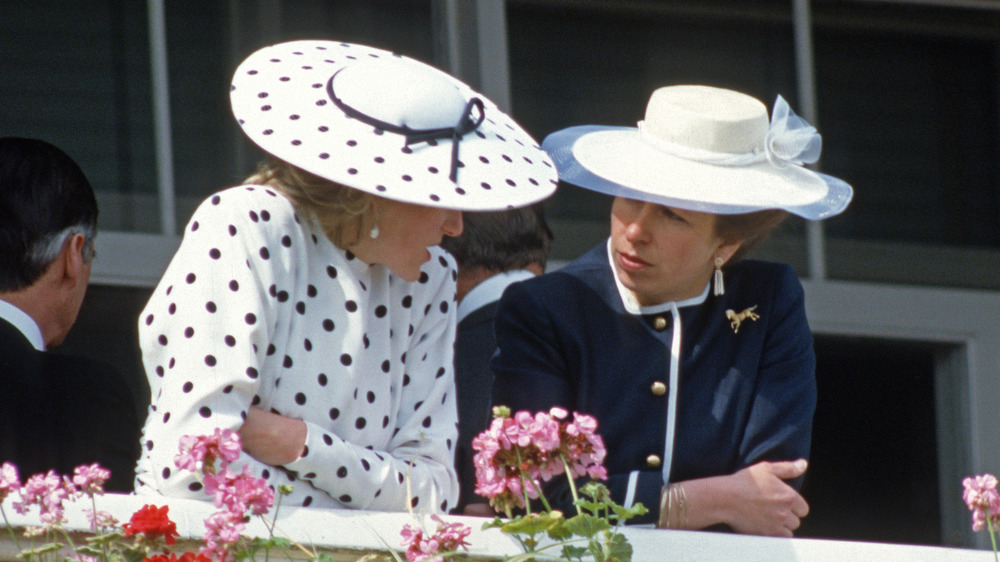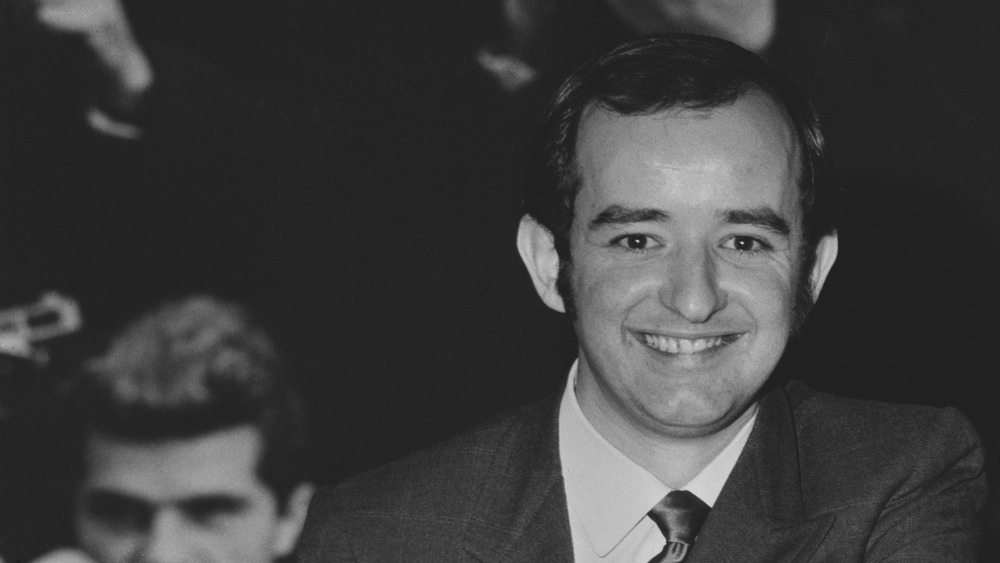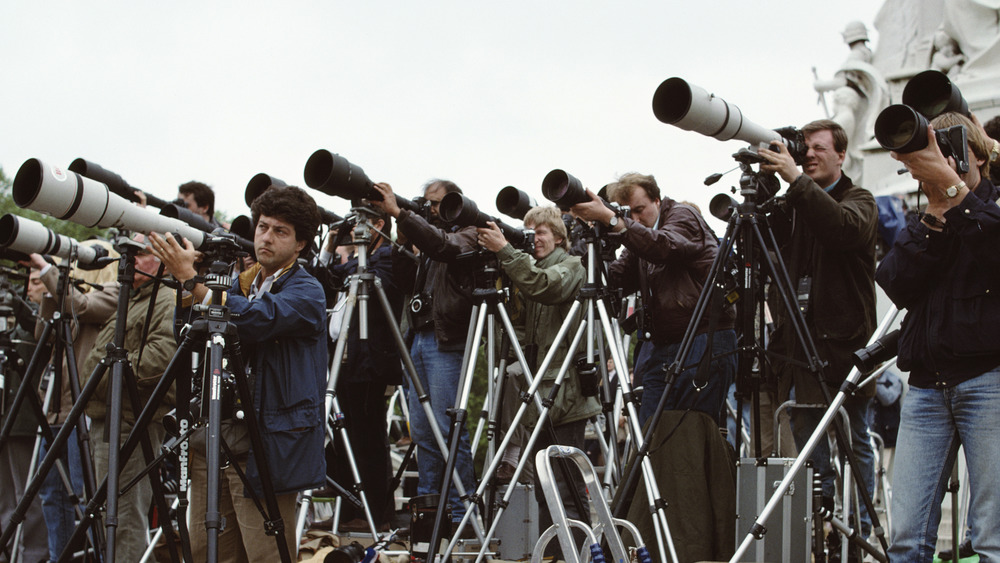Famous People Princess Diana Couldn't Stand
Princess Diana changed countless precedents for British royals. When she joined the royal family in July 1981, 750 million people tuned in to watch the 20-year-old get hitched to Prince Charles. This was publicity unlike any the royal family had ever experienced, and it was just the beginning of what Princess Diana would do to change Buckingham Palace. She quickly became known as the People's Princess due to her incredibly personable disposition. She did crazy-nice things like, you know, kneel down when talking to children and the sick, which was supposedly a quite unroyal thing to do, according to British author Ingrid Seward. Diana always seemed to want to get on people's level, and it fueled her already wild popularity.
To the public, she was consistently gentle, kind, and happy. But of course, behind those aristocratic curtains was a very different Diana — one who was suffering from immediate fame, unattainable expectations, and centuries of traditions that were completely foreign to the former kindergarten teacher. In these struggles, Diana said she encountered little, if any empathy from her new family. The princess said she felt incredibly alone and grew resentful of those from whom she needed the most support. The People's Princess, who befriended countless celebrities from Elton John to Freddie Mercury, wasn't fond of all famous folks. Nobody likes everybody, not even the perfect princess. She rocked the royal family most when providing an open and honest interview with Andrew Morton, author of Diana: Her True Story. Here are a few famous people Princess Diana couldn't stand.
Princess Diana didn't have a good relationship with Queen Elizabeth
Ah, the classic mother-in-law struggle. Royals are just like us after all, right? Queen Elizabeth and Princess Diana did have their issues, though it's not known if they ever directly confronted one another about them. According to Ingrid Seward, a British author who followed the royal family for close to 20 years, Diana said in the beginning, "I have the best mother-in-law in the world." Now, Diana was just entering the royal family and was still feeling the growing pains of princess-hood. Diana often sought out Elizabeth for comfort and literal cries on the Queen's shoulder, which were often about Charles.
Seward said their relationship went downhill in 1992, however, when Diana secretly collaborated on the instantly sensational book Diana, Her True Story. The work thoroughly slammed Prince Charles and established the royal family as completely uncaring for the princess and her numerous struggles. But things had been getting rocky before that as well. As Diana shared in the tapes she provided for the book, Charles had divulged her issues with bulimia to his mother, who quickly passed that information around the palace. Diana said Queen Elizabeth even approached her about it. The Queen "hung the coat on the hook" about Diana's responsibility for the failing marriage. And during a time in which Charles was openly neglecting his wife and seeing Camilla Parker Bowles, Diana became somewhat frigid toward her mother-in-law.
Obviously, Camilla Parker Bowles was a thorn in Diana's side
To put it lightly, Camilla Parker Bowles was quite a wrench in Diana's gears. According to the documentary Diana: In Her Own Words, Camilla was Charles' first real love when they met in the early '70s. But due to her "experience" in dating, the royal family dismissed her as an ineligible wife for the prince, who was bound to the tradition of wedding a virgin with a fabulous pedigree. But Camilla and Charles never stopped seeing each other, even when Diana came into the picture. The Princess of Wales said in her 1992 interview she had been aware of Charles and Camilla's relationship before they were married and had actually wanted to call off the wedding. But, she was discouraged by her sisters, who reportedly told her, "Well, too late Duch, your face is already on the tea towels."
A few years into the marriage, Diana decided to take the Jerry Springer approach (at least by British royal standards) and confront Camilla. The princess said in her secret 1992 interview that it started when she tagged along with Charles to a party he had planned to attend solo. First, the People's Princess shook Camilla's hand rather than giving her the usual kiss, kiss. Gasp! Then she got her competition alone and told the mistress, "I know exactly what's going on" and that she wanted her husband back. Camilla never backed down, though, and eventually married Prince Charles in 2005, eight years after Diana's death.
Things were complicated with Prince Charles
"My husband made me feel so, um, inadequate in every possible way," Diana said in her 1992 interview. It's hard to know where to start when it comes to how the Princess of Wales couldn't stand Charles. From her claims of how he kick-started her bulimia after calling her chubby when she was 19 years old to ignoring her pleas for help when she wanted to commit suicide while pregnant with Prince William, with a helping scoop of an unapologetic affair, it's an understatement to say there's a lot to work with here.
They did manage to stay married for 15 years, which was actually the Queen's decision, since, you know, monarchy and all. According to close members of the royal family, Charles was known for his tendency to make screwed-up comments. When Diana had fainted while they were at an exhibition in Canada, Diana said that Charles had told her after she regained consciousness that she should have "...passed out quietly somewhere else behind a door."
The most famous example of his alleged douchebaggery is perhaps the interview the couple had after announcing their engagement to the public. When asked if they were in love, Diana said "Of course," while Charles chose to express, "Whatever love means." Diana said this completely traumatized her. But the worst, Diana said, was when Prince Harry was born. Charles wanted a girl, and one without red hair.
Princess Anne and Princess Diana didn't hide their feelings
Princess Anne was pretty saucy about her sister-in-law's unorthodox approach to royalty, and she apparently made no attempt to disguise her feelings toward Diana early on. Ingrid Seward, the British author who followed the family for 18 years, told Vanity Fair that Diana actively avoided Anne, who disliked the young woman immediately on account of their differing interests and approaches to royalty.
Anne was more traditional and liked country life and shooting pheasants, while Diana was 11 years younger and enjoyed livin' it up in the city. Royal reporter Richard Kay also told Vanity Fair, "I remember Diana saying 'if Anne's there I'm off,' because Anne would usually say something rather cutting to her." As told by Bedell Smith in Diana in Search of Herself: Portrait of a Troubled Princess (via E! Online), Diana knew of Anne's feelings about her and tried her best not to "rattle Anne's cage." But this seemed to backfire, and the relationship grew even more resentful as Diana intentionally stepped out of tradition by not making her Harry's godmother.
Ken Lennox and Princess Diana had some ups and downs
Ken Lennox is a well-known British photographer who participated in the paparazzi machine that transformed Diana's life, and not for the better. This particular pap took a photograph that Queen Elizabeth II deemed to the press "the blackest day in the history of British journalism."
The photo in question was obtained it what many might describe as an excessive, or perhaps crazy, manner. Lennox told PBS that he had trekked through the jungle to catch sight of the royals on vacation in the Bahamas. Using an appallingly long lens, the nosey photographer shot Diana on a private beach on another island. What he couldn't see at the time was a small, newly announced baby bump. Diana said, "I was horrified because I would never walk 'round looking like that in a bikini."
Later Lennox admitted in an NBC interview, "I had totally overstepped the line by the standards at that time." Now, Diana never outright said she couldn't stand this particular pap. Lennox claims that he, in fact, showed more empathy for her than other photographers during her rise to fame. He told PBS that he helped her lose the paparazzi one day when she was trying to visit her grandmother. He also said that he would ask her for photographs rather than chase her down to get what he wanted. (Well, other than the whole invasion of privacy matter in the Caribbean.) But, Ken Lennox was indirectly a part of the machine that eventually contributed to Diana's death in 1997.
Mark Saunders and Glenn Harvey were incessant
Diana became the "most photographed person in the world," according to Time Magazine, and it undoubtedly had a tremendous impact on her. From the beginning of her budding relationship with Charles, photographers were snapping at the teenager anywhere possible, even through her bedroom window.
According to Time, paparazzi photographers Mark Saunders and Glenn Harvey followed Diana for 13 years. In their book, Dicing with Di, they recount the extreme measures they took to supply tabloids all over Europe of Diana's daily happenings. Sometimes these excursions turned into more adventurous endeavors, like when they climbed mountains to catch her skiing on holidays and stalked her in the middle of the night after her separation from Charles.
Quite unapologetically, they wrote about how they hounded her so incessantly that she would occasionally burst into tears right in front of them. Diana never outwardly said, "I can't stand Mark Saunders and Glenn Harvey. They're mean, and I wish they'd tumble down the very mountain I was skiing on!" But having an instant meltdown from their intrusions is pretty self-explanatory of her feelings toward them.
